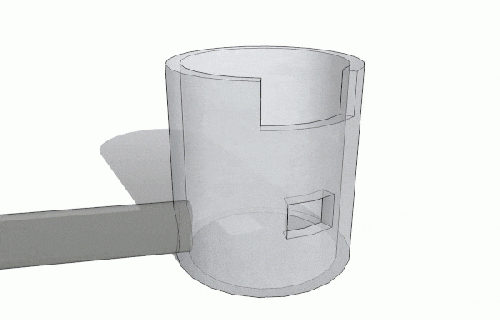Flow control
On a watershed scale, factors contributing to flooding include the total volume of stormwater, the peak flow and the duration of peak flow. All low impact development facilities can help to prevent flooding by providing watershed distributed stormwater storage, and most feature some form of peak flow control device at the outflow or overflow. The limiting factors in the contribution that a system can make to flood control include the total storage and the rate at which the system can be emptied between events. Flow is controlled by:
- the properties of the filter media. See flow through media,
- the exfiltration of water from the practice through an underdrain. See flow through perforated pipe,
- one or more orifices,
- weirs, or
- proprietary low flow devices.
Where either device may be installed, a weir is recommended over an orifice, as they are less susceptible to blockage under freezing conditions.
Orifices[edit]
The smallest diameter orifice accepted by most municipalities to ensure that clogging does not occur in a stormwater system is 75 mm. The preferred minimum orifice size is 100 mm where the effects of freezing are a concern. It is recommended that this latter size be maintained for exposed outlet designs (i.e., reverse sloped pipes).
In instances where a perforated riser outlet is designed, the orifice is protected by the smaller perforations in the riser and a minimum orifice size of 50 mm is acceptable. Where small orifices are required, consideration should be given to providing an overflow outlet which would operate in the event that blockage of the primary orifice occurs.[1]
See also dry ponds
Weirs[edit]
See also blue roofs
Multi-stage Risers[edit]
There are many configurations for multistage risers according to the flow control requirements. It is easiest to begin downstream and design with the the highest return period required in mind. e.g. start by specifying the pipe/culvert component to control the 100 year flow. Then to work backwards to size the lip or weir at the top of the structure to meet the next return period flow.
The riser is then designed with flow through one or more orifices.
Where:
- Z = the depth of ponded water in m,
- Z0 = the elevation of the bottom of the orifice in m,
- H0 = the height of the orifice in m,
- Z1 = the elevation of the weir in m,
- Cw = the weir coefficient,
- Lw = the length of the weir in m,
- Cd = the discharge coefficient of the orifice (often defaulted to 0.6 for a sharp edged orifice),
- Ao = the cross-sectional area of the orifice in m2,
See also[edit]
For review[edit]
https://www.hydrologystudio.com/no-fail-detention-pond-design/
Low flow devices[edit]
Vortex valves have a unique head/discharge relationship. Flow is directed tangentially into the volute to form a vortex that reduces the design peak discharge flow rate from the Vortex Valve far below an equivalent diameter simple orifice.
- Under low flow conditions, water passes through the valve with negligible pressure drop.
- Under high flow conditions, a vortex flow pattern develops within the device creating an air filled core. This phenomenon restricts and throttles flow through the device, creating a back pressure immediately upstream of its discharge. During high flow rates, a vortex valve with a relatively large outlet opening performs similarly to a conventional orifice with a much smaller outlet opening. However, debris that might clog a smaller orifice is able to pass through the Vortex Valve because of the relatively larger flow path opening. The relatively large opening also makes vortex valves less prone to complete clogging from ice formation compared to an orifice of similar specification.[2]
Proprietary links[edit]
In our effort to make this guide as functional as possible, we have decided to include proprietary systems and links to manufacturers websites.
Inclusion of such links does not constitute endorsement by the Sustainable Technologies Evaluation Program.
Lists are ordered alphabetically; link updates are welcomed using the form below.
- ↑ Ontario Ministry of Environment. (2003). Stormwater Management Planning and Design Manual. Retrieved January 15, 2017, from https://www.ontario.ca/document/stormwater-management-planning-and-design-manual/stormwater-management-plan-and-swmp-design
- ↑ Contech Engineered Solutions. (2018). Vortex Valves. Retrieved March 15, 2018, from http://www.conteches.com/products/stormwater-management/stormwater-flow-controls/vortex-valves#tools

